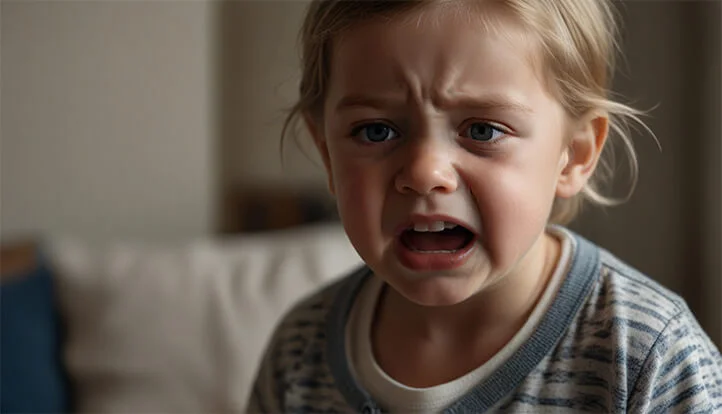Parents often encounter a phase known as the “three-year-old crisis“. This stage in a child’s development is characterized by a range of behavioral issues such as stubbornness, negativism, and frequent tantrums. While this period can be challenging for parents, it is essential to understand that it is a normal part of child development and has its motives.
In this article, I will explore the causes of the three-year-old crisis, its main signs, and provide practical advice for parents. Understanding the specific aspects of this phase will help you better manage your child’s behavioral issues and support their healthy psychological development.

Causes of the Three-Year-Old Crisis
The three-year-old crisis is a turning point in a child’s development when significant changes in their behavior and emotional state occur. Many parents anxiously observe how their once obedient child turns into a stubborn and negative child who frequently throws tantrums and refuses to follow simple requests. However, it is important to recognize that this is a normal stage of development, with its own motives and explanations.
Development of Autonomy and Independence
One of the main reasons for the three-year-old crisis is that at this age, children begin to develop a sense of autonomy and independence. The child starts to realize themselves as a separate individual and strives for greater self-sufficiency.
- They want to do everything on their own, from dressing to choosing toys.
- The child may resist adult help, even if they are not fully able to complete the task yet.
- This expression of healthy autonomy development can create difficulties in parent-child interactions.
It is important to provide the child with opportunities for autonomy and independence in safe situations. For example, let them choose what to wear for a walk or which toy to bring. Praise them for showing patience and effort in completing tasks independently.
Need for Self-Assertion
Around the age of three, children also develop a strong need for self-assertion. They start to show their will and demonstrate independence from their parents.
- The child may refuse to follow simple requests or do the opposite to show their power.
- Such behavior often manifests in the form of stubbornness and negativism.
- It is crucial for parents to learn to respect this desire for independence while setting reasonable boundaries.
Do not take the child’s stubbornness as a personal challenge. Instead, try to understand their needs and offer acceptable choices for them to choose from. For example, instead of insisting on a specific color of clothing, give them a choice between two suitable options.
Expanding Vocabulary and Communication Skills
The three-year-old crisis often coincides with the rapid development of a child’s speech and communication skills. They start to express their thoughts and emotions better with words but may still struggle with emotional self-regulation.
- The expanding vocabulary and ability to communicate may lead to more frequent arguments and conflicts with parents.
- The child may use words to express their negativism or protest.
- It is important to help the child learn to express their emotions in acceptable ways.
Encourage the child to express their feelings with words and discuss the emotions they experience. Teach them to use “I-statements” to express their needs and desires, such as, “I am upset because I want to play with this toy.”
Development of Emotional Intelligence
At the age of three, a child’s emotional intelligence develops actively. They begin to recognize and understand their own emotions as well as those of others. However, they still find it challenging to regulate these emotions.
- The child may quickly shift from joy to anger or frustration, which is expressed through tantrums and emotional outbursts.
- They find it difficult to understand and verbalize the reasons for their emotional reactions.
- Parents should help the child learn to recognize and express their feelings in an acceptable way.
Use books, games, and exercises that help develop the child’s emotional intelligence. Discuss different emotions and their causes, and teach them self-regulation techniques such as deep breathing or visualization.

Signs of the Three-Year-Old Crisis
The three-year-old crisis often comes as a surprise to parents. Their previously obedient and peaceful child suddenly begins to exhibit entirely new behaviors, which can be confusing and concerning. However, these changes in behavior are the signs of the onset of the three-year-old crisis—a normal stage of development that many children go through.
Stubbornness and Negativism
One of the most common signs of the three-year-old crisis is stubbornness and negativism. The child may refuse to follow simple requests, do the opposite, or constantly say “no.”
- This behavior is driven by the desire for independence and self-assertion.
- The child may exhibit negativism even in situations where they previously followed directions without issue.
- It is important to show patience and consistency during these moments, avoiding confrontation and punishment.
Instead of insisting on your demand, offer the child an alternative or redirect their attention to another activity. Avoid arguments and give them some time to calm down and make a decision on their own.
Temper Tantrums and Outbursts of Anger
Tantrums and outbursts of anger are also common signs of the three-year-old crisis. The child may get upset over small things and have loud tantrums that are hard to stop.
- These outbursts are often related to difficulties in regulating emotions.
- The child may use tantrums as a way to attract attention or influence their parents.
- It is important to stay calm and not give in to manipulation but also show empathy and help the child manage their emotions.
Remain calm and do not give excessive attention to the tantrum. Once the child calms down, discuss their feelings and reasons for being upset. Teach them simple relaxation techniques such as deep breathing or counting.
Striving for Independence
At this age, children also strive for greater independence and autonomy. They may insist on doing tasks independently, even if it takes more time or creates a mess.
- This desire for independence is normal and important for the child’s development.
- Parents should provide opportunities for independence while setting reasonable boundaries and ensuring safety.
Allow the child to handle tasks they are capable of doing independently, such as dressing, cleaning up toys, or preparing simple meals. Praise them for their efforts and patience, even if the result is not perfect. Gradually increase the complexity of tasks as the child masters new skills.
Difficulty with Attention Shifts and Flexibility
During the three-year-old crisis, children often have trouble shifting attention and being flexible in their thinking. They may get stuck on a specific idea or action, leading to stubbornness and resistance.
- The child may refuse to switch to another activity or follow instructions if they conflict with their desires.
- They find it hard to accept changes in their usual routine or adapt to new situations.
- Parents should help the child develop flexibility and the ability to shift attention.
Use visual schedules and warnings about upcoming changes to prepare the child in advance. Offer them a choice of several activities so that they feel involved in the process. Praise them for showing flexibility and the ability to switch between tasks.

Overcoming the Three-Year-Old Crisis
The Three-Year-Old Crisis can be a real challenge for parents. The child’s stubbornness, negativism, and constant tantrums can test the patience of even the most experienced parents. However, it’s important to remember that this is a normal stage in a child’s development, and with the right approach, you can successfully navigate this difficult period.
Below, I will provide practical recommendations to help parents effectively manage behavioral issues during the crisis of age 3. I will cover strategies for setting boundaries and rules, using positive reinforcement as a powerful tool for managing a child’s behavior, offering choices, encouraging independence, and stressing the importance of remaining calm and patient.
By following these recommendations, you can establish positive interactions with your child and help them successfully go through this challenging but inevitable stage of development.
Setting Boundaries and Rules
During the Three-Year-Old Crisis, it’s crucial to establish clear boundaries and rules for your child. This helps create a sense of security and structure that is essential for healthy development.
- Set reasonable rules and consistently follow them.
- Explain the rules to your child calmly and patiently, using simple words.
- Avoid excessive strictness or punishments, which can exacerbate negative behavior.
Boundaries should be flexible and take into account the child’s developmental age. For example, instead of forbidding them to be noisy, set rules about where and when it is appropriate to be loud.
Providing Choices and Encouraging Independence
Give your child opportunities to make decisions and be independent in safe situations. This helps satisfy their need for independence and self-assertion.
- Offer your child a choice between two acceptable options (e.g., what clothes to wear or what to eat for breakfast).
- Allow them to perform tasks they can do on their own (e.g., cleaning up toys or getting dressed).
- Praise the child for demonstrating independence and patience.
When offering choices, make sure that both options are acceptable to you. This avoids arguments and gives the child a sense of control over the situation.
Maintaining Calm and Patience
During the Three-Year-Old Crisis, it’s essential to remain calm and patient. By responding to negative behavior calmly and consistently, you help your child better manage their emotions.
- Try not to raise your voice or lose control during tantrums or protests.
- Be patient and allow the child to express their emotions, while setting clear boundaries for unacceptable behavior.
- Use gentle but firm phrases like, “I understand that you’re upset, but it’s not okay to scream.”
If you feel you are losing patience, take a break and give yourself time to calm down. Then return to the situation with a more balanced and rational approach.
Using Positive Reinforcement
Positive reinforcement can be an effective tool for managing a child’s behavior during the Three-Year-Old Crisis. Praise and encourage desirable behavior to reinforce it.
- Use praise, hugs, and other forms of positive attention when the child behaves well.
- Avoid over-reliance on material rewards, as this can lead to dependence on them.
- Be consistent, and gradually reduce the frequency of rewards as desirable behavior becomes a habit.
In addition to praise, you can use a reward system such as stickers or tokens, which the child can exchange for small privileges or toys. This will help solidify desired behavior.
Teaching Self-Regulation and Emotion Management
A key task for parents during the Three-Year-Old Crisis is teaching the child self-regulation skills and how to manage emotions. This will help them better handle difficult situations and avoid outbursts of anger and tantrums.
- Teach your child to recognize and name their emotions using pictures, books, or games.
- Show them ways to deal with strong emotions, such as deep breathing, visualization, or physical activity.
- Practice these techniques together in a calm environment, and then remind them to use them in stressful situations.
- Be a model of emotional self-regulation by showing your child how to cope with your own strong emotions.
Teaching emotion management requires patience and consistency. Over time and with practice, your child will learn to better control their reactions and express their feelings more constructively.
Attention to Attachment Needs
During the Three-Year-Old Crisis, it is also important to pay attention to the child’s needs for attachment and security. Despite their desire for independence, children at this age still need closeness and support from their parents.
- Spend quality time with your child, during which you are fully focused on them and their needs.
- Hug, kiss, and physically demonstrate your love and support.
- Create rituals and traditions that help your child feel secure and strengthen your relationship.
Meeting attachment needs will help reduce the child’s stress and anxiety, which, in turn, will lessen the intensity of the Three-Year-Old Crisis.
Creating Structure and Predictability
During the Three-Year-Old Crisis, children often need structure and predictability. A well-established daily routine and consistency in actions help a child feel secure and better cope with changes.
- Establish a clear daily routine that includes time for meals, sleep, play, and other activities.
- Use visual schedules or a timer to help the child understand expectations and the sequence of events.
- Give the child advance notice of any changes in the routine or upcoming transitions from one activity to another.
Structure and predictability reduce anxiety and stress in the child, which, in turn, helps diminish the symptoms of the Three-Year-Old Crisis.
Additional Strategies
Overcoming the Three-Year-Old Crisis requires patience, consistency, and resilience from parents. Here are a few more effective strategies that can help:
- Ignore minor negative behavior. Try not to react to small misdeeds so as not to reinforce them with your attention. However, do not ignore dangerous or destructive behavior.
- Prevent tantrums. Try to anticipate situations that might trigger a tantrum and prevent them in advance. For example, if the child tends to get tired at a certain time, take a break for rest before they become too upset.
- Distract their attention. Try to shift the child’s focus to another activity or game to stop negative behavior. This is especially effective in preventing tantrums.
- Choose the right time for disputes. Avoid arguments and conflicts when the child is tired or hungry. At such times, they are less able to control their emotions and behavior.
- Use stories or tales. Tell the child short stories or make up tales that illustrate the consequences of negative behavior or reward positive behavior. This will help them better understand expectations and develop desired behavior patterns.
The Importance of Consistency and Parental Unity
To successfully overcome the Three-Year-Old Crisis, it is essential that both parents are consistent in their approach and work together.
- Discuss and agree on the rules and strategies for parenting with your partner.
- Avoid contradictory signals or different requirements from the mother and father.
- Support each other and avoid criticizing your partner’s parenting methods in front of the child.
If you are raising a child with other family members, make sure all adults involved in parenting follow the same rules and approaches.
Support and Professional Advice
If you experience serious difficulties in overcoming the Three-Year-Old Crisis or are concerned about your child’s development and behavior, don’t hesitate to seek help from specialists.
- A pediatrician can assess your child’s development and provide recommendations for their physical and emotional health.
- A child or family psychologist can offer strategies and techniques for managing your child’s behavior and strengthening family relationships.
- Parent support groups can also be a valuable source of information, advice, and emotional support.
Remember that seeking professional help is not a sign of weakness or failure. On the contrary, it is a sign of responsibility and care for your child’s well-being.

Conclusion
The Three-Year-Old Crisis is a normal and temporary stage in a child’s development. Understanding the reasons for the behavior during this transitional period and applying the right strategies will help parents effectively manage it.
Remember, the Three-Year-Old Crisis doesn’t last forever and is a sign of healthy development in your child. By showing patience, consistency, and love, you will be able to successfully overcome this stage.
If you experience serious difficulties or have concerns about your child’s development, don’t hesitate to reach out to specialists (a pediatrician or psychologist). They will provide additional support and recommendations tailored to your family’s specific situation.
Recommended Reading:
- “The Whole-Brain Child: 12 Revolutionary Strategies to Nurture Your Child’s Developing Mind” – by Daniel J. Siegel and Tina Payne Bryson. In this groundbreaking book, neuropsychiatrist Daniel J. Siegel and parenting expert Tina Payne Bryson offer a revolutionary approach to parenting that promotes healthy brain development in children, making them calmer and happier. By applying these recommendations in daily life, you can quickly stop any child’s outburst of anger, end an argument, or ease your child’s fear.
- “Your Three-Year-Old: Friend or Enemy” – by Louise Bates Ames and Frances L. Ilg. Based on child development research, this book offers practical advice for parents. This guide will help you understand what is happening in the mind of a three-year-old child, what problems are typical for children at this age, and how to cope with a child who is sometimes a friend and sometimes an enemy.
- “Toddler Tactics: How to Make Magic from Mayhem” – by Pinky McKay. In this book, parenting expert Pinky McKay explains what to do at each stage of a child’s development and offers simple advice on issues such as communicating with the child, discipline and good manners, healthy eating habits, play and sleep routines, family dynamics, and more.
- “The Happiest Toddler on the Block: How to Eliminate Tantrums and Raise a Patient, Respectful, and Cooperative One- to Four-Year-Old” by Harvey Karp. This practical guide, written by respected pediatrician and child development expert Dr. Harvey Karp, is perfect for parents who want to prepare for the challenging toddler years (starting around eight months) that include the three-year crisis.
- “No-Drama Discipline: The Whole-Brain Way to Calm the Chaos and Nurture Your Child’s Developing Mind” by Daniel J. Siegel and Tina Payne Bryson. Emphasizing the remarkable connection between a child’s neurological development and how parents respond to misbehavior, the authors offer an effective and compassionate plan for handling children’s tantrums. They explain how to reach the child, redirect their negative emotions into positive channels, and turn the three-year crisis into an opportunity for growth. Thus, the cycle of negative behavior (and punishment) is essentially stopped, as problem-solving is elevated to a new level.




